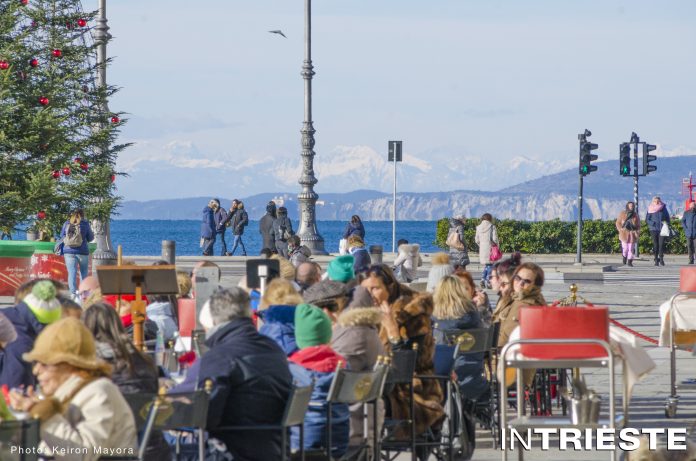by InTrieste
Italy is a country where food serves as more than sustenance — it’s a vital part of cultural identity, a symbol of togetherness, and a source of pride. This is especially evident during the Christmas season when tables overflow with traditional dishes that vary from region to region and sometimes even from family to family. Italian Christmas meals are a celebration of the country’s culinary heritage, with recipes often passed down through generations.
Here’s a closer look at the diverse and delicious foods Italians enjoy during the festive season.
The Christmas Eve Feast: “La Vigilia”
The festivities typically begin on Christmas Eve with “La Vigilia,” a meal rooted in religious tradition. Many Italians avoid meat on this day, instead enjoying a seafood feast called “La Cena della Vigilia.” The number of dishes often reflects Catholic numerology, with seven, nine, or even 13 different seafood preparations gracing the table.
Popular dishes include:
- Baccalà: Salted cod, either fried or stewed in a tomato-based sauce.
- Spaghetti alle Vongole: A simple yet flavorful dish of spaghetti with clams.
- Fritto Misto di Mare: A mix of fried seafood such as shrimp, squid, and small fish.
- Insalata di Mare: A cold seafood salad featuring octopus, mussels, and prawns.
Regional variations abound. In Naples, eel (capitone) is a must, while in Sicily, pasta con le sarde (pasta with sardines) might take center stage.
Christmas Day: The Main Event
While Christmas Eve focuses on seafood, Christmas Day is all about meat. The meal begins with antipasti, including cured meats like prosciutto, salami, and coppa, paired with cheeses, olives, and marinated vegetables. From there, the courses unfold in grand style.
First Course (Primo):
- In northern Italy, stuffed pasta such as tortellini or cappelletti served in broth (brodo) is a classic choice.
- In southern Italy, lasagna or baked pasta dishes like timballo or pasta al forno are popular.
Second Course (Secondo):
- Roasts take center stage, with options like arrosto di vitello (veal roast) or agnello al forno (oven-roasted lamb).
- In central Italy, porchetta—a slow-roasted, herb-stuffed pork roast—is a star attraction.
Side Dishes (Contorni):
- Seasonal vegetables prepared simply but elegantly, such as roasted potatoes, sautéed chicory, or Roman-style artichokes (carciofi).
The Sweet Finale: Desserts
No Italian Christmas meal is complete without desserts, and the options are as varied as the regions themselves.
- Panettone and Pandoro: The iconic Christmas cakes of Milan and Verona, respectively.
- Struffoli: Neapolitan honey-coated fried dough balls.
- Torrone: Nougat with nuts, honey, and sugar.
- Ricciarelli: Almond-based cookies from Siena.
- Cartellate: Rose-shaped pastries from Puglia, drizzled with honey or wine syrup.
Each dessert reflects local ingredients and traditions, providing a sweet insight into Italy’s cultural diversity.
Regional Highlights: Friuli Venezia Giulia
In the northeastern region of Friuli Venezia Giulia, Christmas dishes carry a mix of Italian, Slavic, and Austrian influences, reflecting its unique history.
Christmas Eve:
- Baccalà mantecato (creamed cod) is a staple, often served on toasted bread.
- Seafood risotto or brodetto (fish stew) are common first courses.
Christmas Day:
- A highlight is cotechino con lenticchie (a savory pork sausage with lentils), symbolizing luck and prosperity.
- Roast meats like maialino al forno (oven-roasted suckling pig) or venison are popular, accompanied by sides of polenta and sautéed winter greens.
Desserts:
- Gubana, a spiral-shaped cake filled with dried fruits, nuts, and spices, is a local specialty.
- Presnitz, a pastry roll filled with a rich mixture of nuts, candied fruit, and spices, adds to the festive sweetness.
Drinks and Toasts
No Italian celebration is complete without wine, and Christmas is no exception. Regional wines pair with each course, from crisp whites like Friulano to robust reds such as Refosco. Sparkling wines like Prosecco are popular for toasts, while dessert wines like Ramandolo or Picolit are cherished in Friuli Venezia Giulia.
Liqueurs such as grappa or amaro often conclude the meal, leaving a warming note of tradition and conviviality.
The Day After: Santo Stefano
The feasting continues on December 26, known as Santo Stefano. This day is more relaxed, with families gathering to enjoy leftovers or simpler dishes. In Friuli Venezia Giulia, it might include reheated gubana, alongside a hot cup of coffee or a sip of grappa.
From the Alpine north to the sun-soaked south, Italy’s Christmas table is a mosaic of flavors and traditions, each dish telling a story of history, family, and celebration. For Italians, Christmas is more than a holiday — it’s a feast for the senses and the soul.






























